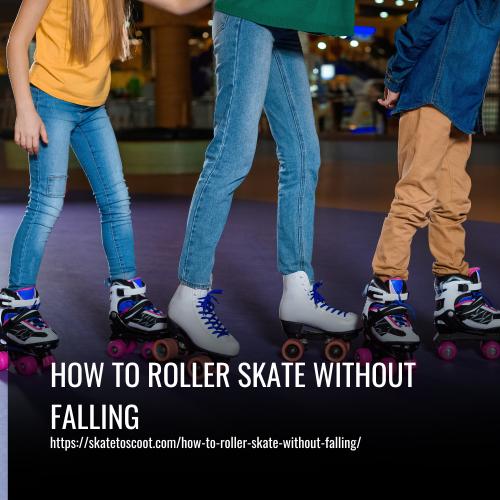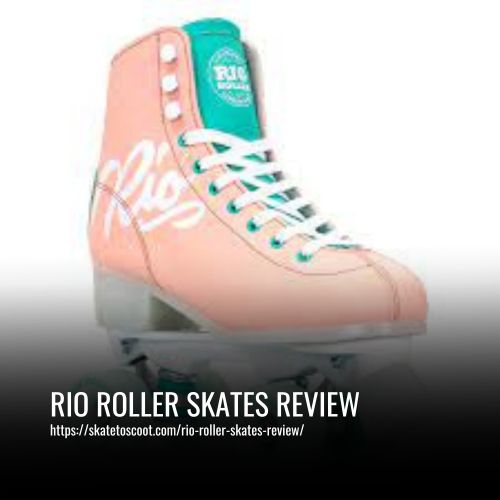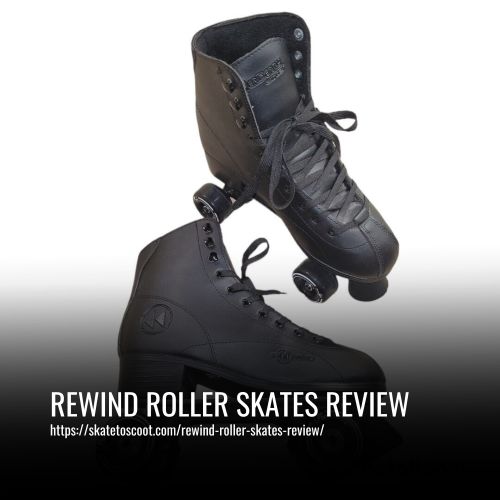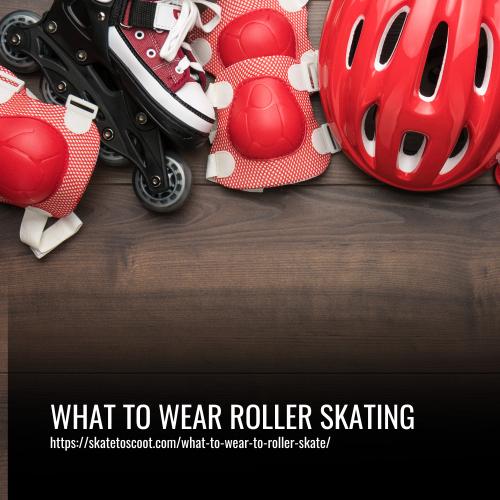As an Amazon Associate we earn from qualifying purchases.
The fear of falling can hold you back from taking up a great new activity like roller skating. But it’s important to remember that everyone takes a few spills when they start and the sooner you get over that fear, the quicker the fun will begin. Here are some tips on how to start roller skating without worrying about falling:
Firstly, practice in a safe environment with expert guidance or a friend who is already experienced. A smaller rink is helpful to get a feel of maneuvering before taking it to bigger rinks.
For any new roller skaters, it’s essential to equip yourself with protective gear such as knee and elbow pads, wrist protectors, and the right skates. It’s best to start at an appropriate level for your skill and find out what skate parks suit your ability. Finally, avoid terrain with sudden inclines or declines like ramps and stairs, to begin with.

Beginner Skaters First Steps
If you’re a beginner skater and you want to know how to roller skate without falling, the first step is to review the basics. Understanding the ‘ready position’ is key here. This stance provides a sturdy foundation for you so that you’re not prone to wobbles once your momentum picks up.
Getting into the ready position is simple – feet should be parallel and one hand’s width apart, knees bent forward over toes, and body upright with the weight falling on the front half of your foot – not the back!
It’s also a good idea for beginner skaters to get some pro tips on how to start skating, maintain moderate speed and stop smoothly. Mastering basic steps like these and transitioning properly between strides and gliding positions can go a long way in helping beginners stay steady on their skates.
1. Skates on Tightly
If you want to learn how to roller skate without falling, then make sure your skates are firmly attached to your feet. To start skating, first, pull the tongue and tuck it into the ankle cuff of your skate’s boot.
Then use both hands to grab onto the lowest cross of your laces near your toes, pulling each one tightly as you go up. Repeat this process until all laces have been pulled and then finish off by tying them securely at the top.
This tight attachment ensures that your skates will stay on securely throughout skating, giving you control of movements with conscious effort. While having properly fitting skates is also essential, a good lace-up job will make all the difference in skating without falling!
2. Practice falling forward!
If you’re worried about falling while roller skating, then it’s important to practice falling forward. This will help you become comfortable with the idea of hitting the ground with your protective gear instead of potentially injuring yourself.
To perfect this technique, you should try kneeling and jumping to touch your knee guards. Doing this will allow you to understand just how safe and secure your knees are when wearing proper pads, reassuring you that falling forward onto them is preferable to toppling backward onto your lower back or butt.
Additionally, practicing hits from a standing position can also help reduce your fear of falling significantly. To do this, stand in the Ready position (feet parallel and side by side) on some grass with your hands up in front of you, then bend your knees deeply until you roll over your front wheels – making sure to hit both the knee pads and wrist guards first.
This exercise should be done carefully though; only those without existing knee or back pain/weakness should attempt it.
3. Learn the Ready Position (statically)
Learning the Ready position on rollerskates is a great way to prevent falls. First, start off by standing still on grass or carpet and positioning your feet in parallel, about a hand’s width apart. Then, bend your knees until your toes (viewed from the side) are covered by your knee pads. It’s important to adjust both ankle straps so that you can feel them securely supporting your shins.
Once your straps are adjusted correctly, you should be able to comfortably bend your knees to achieve the Ready position- staying low enough that you can feel the ankle strap but not so close that you cannot move! Statically practicing this position will give you the confidence and control needed to confidently rollerskate without falling.
4. Ready Position rolling
When it comes to roller skating without falling, mastering the Ready position while rolling is key. To start skating, be sure to roll into a Ready position for extra comfort and control, then gradually increase your speed.
To ensure you maintain a perfect ready position every time, make sure you keep these things in mind: have feet parallel and one hand’s width apart (with knee pads touching), bent knees so that your weight is on the balls of your feet, shins supported by ankle straps and heels slightly lighter in skates if the weight is correctly on the balls of feet.
5. Keep your speed low
Keeping your speed low is key to becoming a successful quad skater without falling. This may sound like common sense, but many skaters are unaware that it’s not only how fast you’re going, but also how you’re controlling your speeds that makes all the difference.
Should you wear protective gear when skating?
The answer to the question “should you wear protective gear when skating?” is a resounding YES. Wearing wrist guards and knee pads can help reduce the frequency of falls, which is especially important for beginner skaters. It also provides added protection against injuries should you happen to fall.
When wearing protective gear, reaching your hands in front of you when feeling a wobble can help regain balance and regroup in a rolling ready position. Without it, there’s nothing to stop you from falling backward onto an unprotected wrist or shoulder, which could cause serious injuries. Even if you’ve been skating for months with no major problems, it’s always better to be safe than sorry!
Is it possible to roller skate without falling?
It is an important question to consider. The answer: sadly, no. It doesn’t matter how much practice you’ve put in or how skilled you are, falls are an inevitable part of the experience.
At the root of it all is friction – between your feet and the ground, something out of your control will eventually cause us to lose balance and fall. Then there are those slips that can’t be avoided – a crack here and a wet spot there – all adding up to a loss of equilibrium.
So no matter how much we’d like it not to be true, skating without falling isn’t possible because there are too many uncontrollable obstacles. Science has given us some insight into what enables skaters to survive longer- lighter weights and better surfaces maximize your chances as well as slowing down when skating. But there’s no guarantee – keeping yourself upright ultimately depends on luck!
Tips for falling safely while skating
Here is some tips for Falling Safely While Skating:
- Choose a Direction: When you feel yourself losing balance, try to pick a direction to fall in. This can help minimize the impact and prevent injuries.
- Protect Your Tailbone: Falling directly on your tailbone can be extremely painful. Think ahead and try to lean so that one side of your bum hits the ground first to avoid direct impact on the tailbone.
- Protect Your Fingers: It’s natural to use your hands to break your fall, but quickly move them off the floor or into fists to avoid someone skating over your fingers and causing injury.
- Lower Your Center of Gravity: When you sense that a fall is imminent, try to lower your center of gravity by getting on one knee and sliding to minimize the impact of the fall on your body.
Do you have to fall to learn how to skate?
Many have argued that you have to fall to learn how to roller skate, but I believe there is a better way. By following an experienced and certified skate coach either in person or online, and learning the correct technique, it’s possible to learn how to skate without ever falling.
Though it may feel like falling is random, it is actually a result of something that happened in the moments leading up to the loss of balance. To avoid ever having to take those spills, focus on mastering the skills needed for proper skating mechanics from the start.
Skating teaches us to be aware of our body, its movements, and all other elements necessary for successfully controlling speed with wheels on our feet. Unfortunately, many people never receive the right resources needed for this level of control and give up after taking one too many bruises!
FAQs
A mistake that inexperienced skaters make when they coast is placing their feet too close together, which creates a narrow base. This can cause them to fall back if their weight is over the back wheels.
To beginner roller skaters, the Toe Stop Drag is an effective way to slow down. When executing this move, shift your weight more towards the toe stops.
Conclusion
If you want to get good at roller skating without falling, it’s important to be patient and practice a lot. Start with the basics like learning how to balance on the skates and practice in an area that is not crowded or slippery.
Once you get the hang of it, you should gradually speed up and even try out some tricks. It takes time and commitment but mastering roller skating can be very rewarding. So what are you waiting for? Throw those skates on and give it a go – everyone falls the first time around!
Amazon and the Amazon logo are trademarks of Amazon.com, Inc, or its affiliates.



